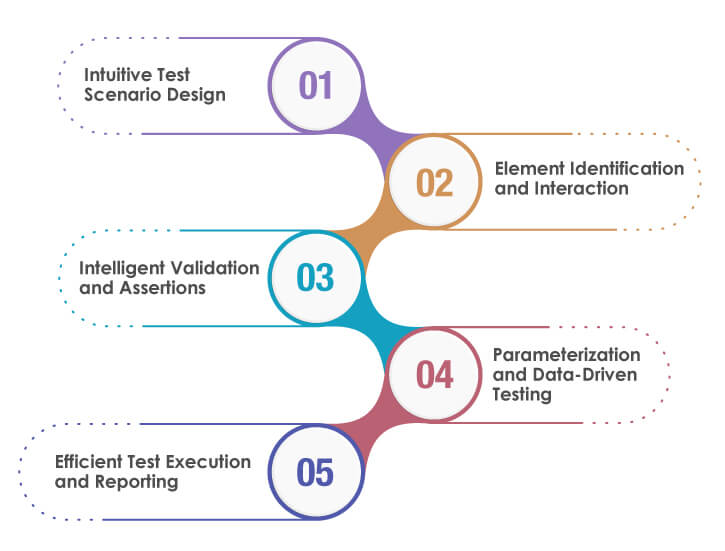
Codeless automation testing represents a streamlined approach to automation testing, eliminating the need for script writing. Crafting automation scripts can pose significant challenges for QA engineers, as it demands writing code in various programming languages, which is both demanding and time intensive. By adopting codeless automated testing, you can drastically reduce testing time, particularly for repetitive test cases, all without the need for coding.
Codeless Automation Testing
In the era of codeless testing tools available in the market, you’ll find a range of user-friendly features that simplify the testing process. These include:
– Intuitive Drag and Drop Interface.
– Efficient Record and Playback Functionality.
– Seamless Integrations with Machine Learning (ML) or Artificial Intelligence (AI) technologies.
– Reduced Maintenance Efforts.
This approach not only accelerates testing but also ensures that the testing process remains accessible and efficient, even for testers without extensive coding experience.
How does Codeless Automation Testing Work?

Codeless automation testing, also known as no-code/low-code testing, involves using tools and platforms that allow individuals to create automated tests without writing traditional lines of code. This approach enables testers and non-technical users to design and execute test cases using a graphical user interface (GUI) or a simple scripting language, eliminating the need for programming expertise.
Here’s an overview of how codeless automation testing works:
Intuitive Test Scenario Design:
Codeless automation testing starts with the development of intuitive and easily understandable test scenarios. Testers use a visual interface, often equipped with drag-and-drop features and a palette of predefined testing actions. The intuitive design of the interface allows testers to select actions that simulate user interactions with the application, arranging them in the desired order to construct a logical test flow.
Element Identification and Interaction:
Within the codeless testing tool, testers can easily identify and interact with elements of the application under test (AUT). Through the graphical interface, testers can select various elements such as buttons, input fields, dropdowns, and other user interface components without requiring any programming knowledge. This allows for simulating user actions like clicks, input entries, and navigations.
Intelligent Validation and Assertions:
During the creation of test scenarios, testers define validation points and assertions within the test steps. These validation points are critical for verifying the correctness of the application’s behavior. The tool provides predefined validation options and allows testers to set conditions and expectations. Assertions aid in ensuring that the application meets the desired criteria and functions as intended.
Parameterization and Data-Driven Testing:
Codeless automation testing enables parameterization, where testers can input data directly into the test steps. This could be either manually entered data or sourced from predefined datasets. The ability to use different sets of test data allows for data-driven testing, helping verify the application’s behavior under various conditions and inputs.
Efficient Test Execution and Reporting:
Once the test scenarios are created and configured, testers can initiate the execution of the automated tests directly from the codeless testing tool. The tool executes the defined test steps, interacts with the application based on the specified actions, validates the outcomes, and generates detailed reports. These reports include information on test execution status, duration, pass/fail results, and any encountered issues. The generated reports are valuable for identifying potential defects and providing insights into the application’s quality.
Significance of Choosing the Right Codeless Automation Testing Tool

Selecting the right codeless automation tool holds immense significance in the realm of software testing and quality assurance. Here’s why making this choice wisely is crucial:
Efficiency and Productivity:
The right codeless automation tool streamlines test case creation and execution. It empowers testers to design and execute tests swiftly through user-friendly interfaces, saving a significant amount of time and effort. This efficiency boost is particularly valuable in fast-paced development environments.
Reduced Learning Curve:
Codeless tools are designed to be intuitive, making them accessible to a broader range of team members, including those without coding skills. This reduces the learning curve and allows for easier onboarding of new team members, ultimately saving time and resources.
Cost-Effective:
Investing in the right codeless automation tool can be cost-effective in the long run. It minimizes the need for hiring specialized automation engineers and reduces the maintenance overhead associated with traditional scripted automation.
Flexibility and Scalability:
The ideal codeless tool offers flexibility to adapt to evolving testing needs. It should be capable of handling a variety of test scenarios and be scalable to accommodate the growth of your project.
Reliability and Robustness:
Your chosen tool should provide reliable and robust testing capabilities. This means it should support various testing types, handle complex scenarios, and generate dependable test results.
Integration Capabilities:
Integration with your existing development and continuous integration/continuous deployment (CI/CD) tools is crucial. A well-chosen tool seamlessly integrates with your workflow, enhancing the overall efficiency of your software development process.
Support and Community:
The availability of a strong user community and reliable customer support for the tool is vital. This ensures that you have resources and assistance readily available when encountering challenges or seeking to optimize your testing processes.
In essence, the right codeless automation tool can be a game-changer, enabling your QA team to deliver higher-quality software in less time, all while enhancing collaboration and reducing the complexities associated with traditional script-based automation. It’s a strategic decision that can significantly impact your software development lifecycle for the better.
List of Features to Look for in a Codeless Test Automation Tools:
Application development firms increasingly embrace codeless test automation tools to keep up with the rapid cadence of new product releases within their CI/CD pipelines. Consequently, they can significantly reduce both the expenses and the time required for repetitive testing, all without the necessity of manual code creation.
In the midst of the continuously rising popularity of codeless test automation, the market boasts an array of over a dozen automated testing tools to consider. Nevertheless, it’s important to discern that not all these tools meet the criteria of being labeled as “genuine” codeless test automation solutions. To help with your selection, here are key features to seek in a codeless test automation tool:
Is it capable of performing resource-intensive and costly tests without requiring proficiency in a specific programming language?
– Does it facilitate application testing on a variety of devices and operating systems?
– Does it offer a straightforward and user-friendly interface, akin to an “Action Logic Editor”?
– Does it come with features for “In-Sprint and Self-healing” capabilities?
– Does it support seamless integration with AI and machine learning technologies?
Does it offer unified automation capabilities spanning various platforms, encompassing Web and Mobile applications, APIs, Desktop applications, and Mainframes?
Let’s take a closer look at the top five codeless test automation tools available for your testing needs:
Top Four Codeless Automation Testing Tools

UiPath
UiPath is a leading robotic process automation (RPA) platform that has gained prominence in the automation landscape for its user-friendly and codeless automation capabilities. Codeless automation, sometimes referred to as “low code” automation, is a significant advantage of UiPath, as it allows individuals with limited programming experience to create and deploy automated workflows efficiently.
Its user-friendly interface, extensive library of activities, and commitment to scalability and security make it a powerful tool for both beginners and experienced automation professionals. By enabling users to automate without extensive coding, UiPath empowers organizations to achieve greater efficiency and productivity in their day-to-day operations.
Here are some of the core features of the tool:
– It allows users with limited or no coding experience to create automation processes.
– Provides a library of pre-built automation activities for various tasks.
– Create and reuse custom workflows and activities, promoting efficiency.
– Includes debugging and testing capabilities for identifying and fixing issues in workflows.
– Supports integration with APIs, databases, and web services to enhance automation.
Enables organizations to start small and scale automation efforts as needed.
Katalon Studio
Katalon Studio stands as one of the foremost codeless test automation tools, providing a spectrum of testing capabilities encompassing APIs, web applications, and desktop applications.
This tool is designed for accessibility, catering to both novice and seasoned software testers alike. It boasts a user-friendly interface equipped with features like record and play, along with a drag-and-drop editor. Furthermore, software testers have the flexibility to seamlessly integrate external libraries into Katalon Studio, simplifying test execution without the need to build the framework from the ground up.
Here are some of the core features of the tool:
– Included are pre-designed project templates, test case libraries, and object repositories.
– Enhanced collaboration capabilities for agile teams through integrations with platforms like Slack, GitHub, and others.
– Empowers technical users to craft advanced automation scripts utilizing Selenium or JavaScript.
– Enables the incorporation of native plugins for continuous integration.
– Offers an array of extensive reporting functionalities.
TOSCA
Test Orchestration, Automation, and Reporting,” is a comprehensive test automation tool that offers codeless automation capabilities. Codeless automation is a paradigm shift in the world of software testing, enabling testers and quality assurance professionals to create and execute test automation scenarios without writing complex code scripts.
TOSCA has gained popularity for its user-friendly, codeless approach to test automation, making it accessible to a broader range of professionals, including those without extensive coding skills. TOSCA as a codeless automation tool offers a powerful solution for organizations looking to accelerate their test automation efforts while minimizing the reliance on coding expertise. Its intuitive interface, extensive integration options, and focus on reusability make it an attractive choice for teams seeking efficient and effective test automation.
Here are some of the core features of the tool:
– Utilizes keywords to abstract and simplify test case creation and management.
– Encourages the reuse of test modules, test cases, and components for efficient automation.
– Offers extensive integrations with various tools and technologies, including test management systems and CI/CD pipelines.
– Generates comprehensive test execution reports and provides analytics on test results.
– Facilitates efficient regression testing to catch and prevent software regressions.
TestIM
Testim is an all-encompassing AI-driven testing platform that assists teams in automating tests with ease, reliability, and collaborative efficiency. Leveraging dynamic and intelligent locators, Testim adeptly adapts to alterations within the Application Under Test (AUT), autonomously generating and executing tests. Furthermore, this platform harnesses the power of machine learning to craft, conduct, and oversee tests, leading to a substantial reduction in the time required for test creation and execution, with the capability to simultaneously perform thousands of tests.
Features:
– Testim’s intelligent and adaptable locators automatically generate tests, simplifying the process of keeping pace with rapid releases and UI modifications for teams.
– It seamlessly integrates with your existing CI/CD pipelines and collaboration tools.
– With Testim’s visual test editors, test creation becomes effortless, catering to both technical and non-technical team members.
– The platform provides comprehensive test reports and robust bug checkers, facilitating comprehensive test analysis.
Conclusion
In conclusion, as we step into 2024, the landscape of software testing is rapidly evolving, and codeless automation testing tools are at the forefront of this transformation. These tools are reshaping how testing is conducted, making it more accessible, efficient, and collaborative for teams across various domains and industries.
While the list provided here showcases some of the leading options available, it’s essential to remember that the right tool for your organization depends on factors like your project requirements, team expertise, and budget. Therefore, it’s advisable to evaluate these tools thoroughly and consider how they align with your testing objectives before making a decision.
Codeless automation tools are not only streamlining the testing process but also contributing to the broader goals of achieving faster time-to-market, ensuring software quality, and enhancing collaboration between development and QA teams. Embracing these tools in your testing strategy can give your organization a competitive edge in delivering high-quality software products that meet user expectations in the dynamic landscape of 2024 and beyond.
Should you want any Codeless automation testing services, let’s connect and discuss how TestingXperts can help your business!
Discover more
Get in Touch
Stay Updated
Subscribe for more info




